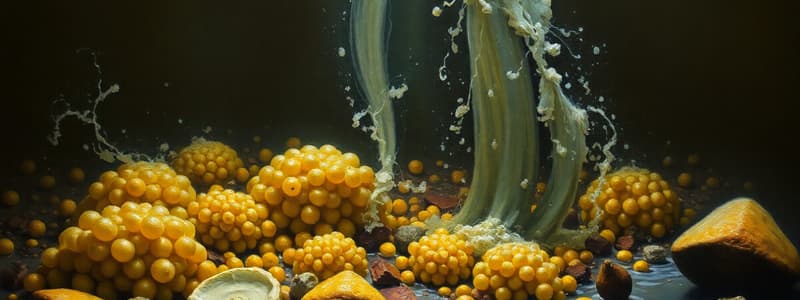Podcast
Questions and Answers
What is the primary advantage of uric acid excretion over ammonia?
What is the primary advantage of uric acid excretion over ammonia?
- It is less toxic and conserves water. (correct)
- It is easier to eliminate through gills.
- It requires less energy for synthesis.
- It can be stored in the kidneys indefinitely.
Which of the following animals is classified as ammonotelic?
Which of the following animals is classified as ammonotelic?
- Birds
- Reptiles
- Mammals
- Marine fishes (correct)
In mammals, where is ammonia converted into urea?
In mammals, where is ammonia converted into urea?
- Lungs
- Kidneys
- Intestines
- Liver (correct)
What term describes the excretory process in which animals eliminate urea?
What term describes the excretory process in which animals eliminate urea?
Which of the following is true regarding the excretion of ammonia?
Which of the following is true regarding the excretion of ammonia?
Flashcards are hidden until you start studying
Study Notes
Waste Products
- Animals generate various waste products through metabolic processes and excess ingestion.
- These wastes include ammonia, urea, uric acid, carbon dioxide, water, and ions like sodium, potassium, chloride, phosphate, and sulfate.
Elimination of Wastes
- The body eliminates these waste products, either fully or partially, through excretion.
- Excretion focuses on removing nitrogenous wastes – ammonia, urea, and uric acid.
Ammonia
- Ammonia is the most toxic form of nitrogenous waste.
- Its elimination requires a large amount of water.
- Ammonotelic animals, like bony fish, aquatic amphibians, and aquatic insects, primarily excrete ammonia.
- Ammonia, due to its high solubility, is excreted through diffusion across body surfaces or gill surfaces in fish.
- Kidneys play a minimal role in removing ammonia in these animals.
Urea
- Urea is less toxic than ammonia, allowing for water conservation.
- Ureotelic animals, such as mammals, terrestrial amphibians, and marine fish, mainly excrete urea.
- Ammonia produced during metabolism is converted into urea in the liver.
- Urea enters the bloodstream and is then filtered and excreted by the kidneys.
- Some urea can be retained in the kidney matrix to regulate osmolarity.
Uric Acid
- Uric acid is the least toxic form of nitrogenous waste, allowing for maximum water conservation.
- Uricotelic animals, including reptiles, birds, land snails, and insects, excrete uric acid.
- Uric acid is excreted as a pellet or paste, minimizing water loss.
Studying That Suits You
Use AI to generate personalized quizzes and flashcards to suit your learning preferences.




